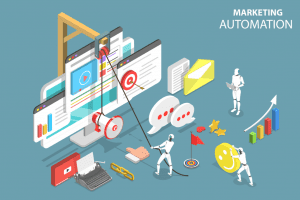
A Guide to Successful Marketing Optimization
Trying to manage all of your marketing efforts can be a time-consuming process. There are only so many hours in a day and if you have a robust marketing strategy, then finding time to perform basic marketing tasks can be challenging. It’s why marketing optimization is so important. The idea of marketing optimization is to improve the efficiency of your marketing efforts and maximize your desired outcomes. Effective marketing optimization can help make your strategy easier to manage and more successful to boot. The following guide lists the steps you need to follow to begin utilizing marketing optimization.
Steps You Need to Follow for Marketing Optimization
1. Analyze Your Marketing Data
 You’re not going to be able to optimize your marketing efforts if you’re unable to identify existing issues and challenges facing your marketing process. Collect and analyze data about your current campaign and website performances in order to identify various weaknesses and/or inefficiencies within your marketing strategy. For example, maybe your email list grows at a sufficient rate, but email open-rates seem to be going down. Or maybe your social media follower numbers are growing, but your web traffic isn’t.
You’re not going to be able to optimize your marketing efforts if you’re unable to identify existing issues and challenges facing your marketing process. Collect and analyze data about your current campaign and website performances in order to identify various weaknesses and/or inefficiencies within your marketing strategy. For example, maybe your email list grows at a sufficient rate, but email open-rates seem to be going down. Or maybe your social media follower numbers are growing, but your web traffic isn’t.
2. Identify What Issues Need Addressing
After analyzing your data, determine what areas could benefit most from marketing optimization. There are a few common ones to consider.
-
Advertising
Narrow down your audience by identifying your business’s buyer personas. When you have a detailed description of your ideal customer, you can focus your ad campaigns on the correct audience. When you’re reaching the right people, you no longer need to worry about wasting money on failed campaigns.
-
Landing Pages
If your landing pages are not generating traffic or leads, you need to look into ways to optimize them. Your social media, SEO and paid advertising should all be leading back to your landing pages. Review each page’s copy and see if it relays the correct message you want your audience to see. If your copy does not align with your company goals and values, visitors will get the wrong message. Additionally, rethink your layout and design, including font, colors and images. You can use different CTAs to test what your audience responds most positively to.
-
Emails
Your email audience is important because you already know they opted in to hear from you. You want to keep them engaged and interested in your business. You need to optimize all aspects of your email campaigns, including times sent, layout, copy and audience. Look into automation tools that will help.
Email Marketing Metrics You Should Keep in Mind and What They Mean
3. Determine Automation Opportunities

In addition to identifying issues that need to be addressed in your marketing strategy, marketing optimization also allows you to identify opportunities for marketing automation. Automating certain processes can help improve results by speeding up the completion of tasks and improve accuracy by minimizing errors. The use of automation also helps cut down on tedious, time-consuming manually done tasks, therefore giving you and your team a significant amount of time to dedicate to more important jobs.
Take the previous email marketing example. You likely have customer emails that no longer exist, are no longer being used, or the recipients haven’t engaged with your brand for a long time. To remove them, you can implement an email validation (also referred to as email verification) automation tool. Such a tool can comb through your email list and automatically find non-responsive email addresses to remove. This gives you more time to focus on the content of your emails and tailor them toward the active recipients. It also takes the inactive recipients out of your analytics, giving you a more accurate representation of your email performances.
You can also use automation to segment your email list using the personal information you have from your recipients. Segmenting your email list can improve your ability to email relevant content to different recipients. This boosts your email open rate and improves the overall effectiveness of your email marketing strategy. Making your content more relevant to recipients means they’re less likely to ignore emails or unsubscribe from your email list.
4. Execute Your Plan
Optimizing your marketing strategy isn’t as easy as simply doing it. You need to obtain organization alignment, which means working with your team to prioritize responsibilities and inform the proper stakeholders. Certain stakeholders can provide insight into the process, after all. This helps you highlight the goals that you want to achieve. You also need to make sure that you have the resources to execute your plan. Your team may already have a plate full of responsibilities. You will need to efficiently manage who is responsible for what task and how they need to prioritize their work.
5. Continue To Optimize Your Marketing Efforts
Optimizing your marketing strategy may take some time depending on the resources at your disposal. However, once you finally execute your plan, you still need to continue optimizing your marketing strategy. There’s no guarantee that the changes you’ve made will be effective, after all. You’ll want to keep collecting and analyzing data so that you can continually find ways to further optimize your marketing efforts. You may discover that you missed more ways to optimize your marketing strategy. Odds are you’ll be implementing new tactics that will need to be optimized as well.
Marketing optimization allows you to pinpoint problem areas in your marketing strategy and to address them. Optimizing your marketing strategy also gives you the opportunity to obtain a big-picture view of your marketing efforts. This makes it easier to prioritize your tasks and ensure that you’re focusing on the most important tasks at hand.

Dan Gartlan helps companies of all kinds drive their business initiatives and achieve their goals with strategic marketing programs that deliver results. As President of Stevens & Tate Marketing, he has over 20 years experience across various industries, and continues to share his expertise to build brands nationwide.





